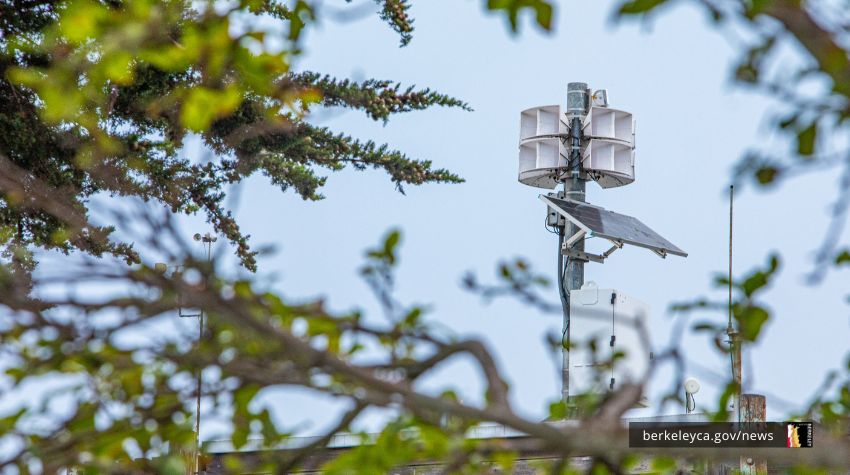Emergency Notifications
Sign up now for emergency alerts and learn where to find reliable information in an emergency.
In an emergency, officials may use different tools to share information and instructions. Get familiar with these tools now, and sign up if needed, to be ready to get alerts in an emergency. To ensure that you have access to information from multiple sources in an emergency, review the available systems below.
BERKELEY'S EMERGENCY ALERTING SYSTEMS
During an emergency, check these sources for instructions and information for the Berkeley community:
AC Alert
Sign up for AC Alert, Berkeley’s main emergency alerting system, to get alerts about addresses of interest including locations you care about – such as your home, office, or a child’s school.
AC Alert can send voice alerts to phones, SMS text messages, email, and TTY/TDD messages. AC Alert is an opt-in system, so if you do not sign up, you will not receive these vital alerts. In addition, if your information changes, you must update the system in order to continue receiving alerts.
You can see the latest AC Alert messages in Alameda County at the AC Alert Notifications page.
Emergency Map
During an emergency, review Berkeley’s Real-Time Emergency Map to find emergency information, like evacuation orders or open shelters.
Bookmark the map on your web browser so you can quickly find it in an emergency. Take note of how to navigate the search bar to find information on the locations you care about. Knowing how to use the website means you can act faster in an emergency.
Outdoor Warning System
In an emergency that requires people in Berkeley to take immediate action, you may hear a siren and voice announcement from the City of Berkeley’s Outdoor Warning System.
The City of Berkeley routinely conducts "quiet testing" of its outdoor warning system that is not audible to the public. The City also schedules public tests of the Outdoor Warning System and publicizes those tests through AC Alert, social media, and Community Messages.
Social Media
Follow the City of Berkeley’s X (Twitter) account. This account may offer additional emergency information.
-
X (Twitter): @CityofBerkeley, @BerkeleyPolice
-
Threads: @CityofBerkeley
-
Instagram: @cityofberkeley, @BerkeleyFireDept
-
Nextdoor: City of Berkeley, Berkeley Fire Department, Berkeley Police Department
Also, if you have not signed up for AC Alerts, you can still monitor Alameda County Office of Emergency Service's X (Twitter) account for AC Alert messages throughout Alameda County.
Website
During a major emergency, information will also be available in accessible formats on the City of Berkeley website.
Your Community
Share emergency information and instructions with the people around you. Verify that information is from a credible source. Encourage others to sign up and prepare to use these systems now, before an emergency occurs.
These systems are not guaranteed to work in an emergency. Please note that some systems require you to sign up or to purchase special equipment to receive alerts.
OTHER EMERGENCY ALERTING SYSTEMS
During emergencies, the systems below may also have critical information for the Berkeley community since officials may use many different tools to communicate information and instructions.
Nixle
The Berkeley Police Department sends out crime prevention tips and alerts through Nixle encourages community members to set up an account to personalize messages they receive.
Wireless Emergency Alerts (WEA)
Wireless Emergency Alerts (WEAs) are short emergency text messages officials send to smartphones. Government agencies send WEA messages to alert community members to emergency situations requiring their attention, such as a shelter-in-place or evacuation order.
If there is a critical threat to the Berkeley community, officials may send out a WEA message to cell phone towers in the affected area. The cell phone towers will send the message to all phones within reach, even if they are outside of the affected area.
You cannot sign up to receive WEA messages, and you should not rely only on WEA for your emergency alerts. WEA messages are very brief and may not contain all of the detailed instructions you might need in an emergency. Instead, sign up for AC Alert and prepare to receive emergency information from the other sources described on this page.
PG&E Outage Alerts & Map
PG&E provides outage to both customers and the community. Sign up for alerts on the Public Safety Power Shutoff Notifications page or call PG&E at 1-866-743-6589.
PG&E’s real-time outage map provides current information about power outages and estimated restoration times.
Radio - 1610 AM
1610 AM is an FCC-licensed radio station run by the City of Berkeley. The station plays recorded messages. In a disaster, the City may use 1610 AM to disseminate emergency information and instructions to the Berkeley community.
The 1610 AM broadcast is audible in most, but not all, areas of Berkeley. The City has authorized KPFA radio to rebroadcast or simulcast the 1610 AM signal on KPFB - 89.3 FM. In an emergency, KPFA staff will determine whether or not to rebroadcast or simulcast the 1610 AM signal.
Television
All television channels will broadcast messages sent by Alameda County through the Emergency Alert System. Local news networks may also carry specific information and instructions from authorities.
Emergency Alert System (EAS)
The Emergency Alert System (EAS) is the national public warning system. It requires television and radio broadcasters to enable the President to address the American public during a national emergency. Authorities may also use the system to deliver important emergency information, such as AMBER alerts and weather information targeted to specific areas.
In Berkeley, your EAS radio stations are KCBS - 740 AM, KQED - 88.5 FM, and KSOL - 98.9 FM (Spanish).
WarnME (UC Berkeley)
WarnME is UC Berkeley’s alert and warning service for UC Berkeley students, staff, and faculty. WarnME is not the same as the AC Alert system. You must have an @berkeley.edu email address to be eligible to receive these alerts.
School Systems
Some schools use their own alert and warning systems to communicate with parents and community members during emergencies. Reach out to your child’s school directly to learn more about the systems they use.
Earthquake Warning California
Earthquake Warning for California is the country’s first earthquake early warning system. The MyShake App can activate your smart phone to alert you to drop, cover, and hold on before earthquake shaking starts.
DISCOVER TOOLS AND RESOURCES
Download more information on the emergency alerting systems.
Berkeley’s Real-Time Emergency Map
City of Berkeley’s Outdoor Warning System
Federal Emergency Alert System - Federal Communications Commission (FCC)
Country-wide Wireless Emergency Alert Map
Public Safety Power Shutoff Notifications
WarnME - U.C. Berkeley’s alert and warning system



